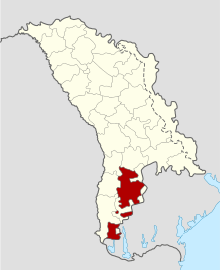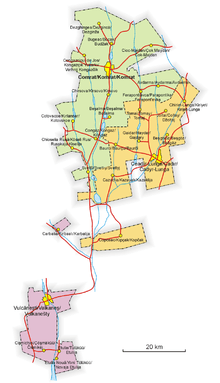Gagauzia
Gagauzia is an autonomous region of Moldova. It has a population of about 135,000 people, 83% of whom are of the Gagauz Turkic ethnic group.
Understand
History

According to some theories, the Gagauz people descend from the Seljuq Turks who settled in Dobruja following the Anatolian Seljuq Sultan Izzeddin Keykavus II (1236–1276). One clan of Oghuz Turks is known to have migrated to the Balkans during intertribal conflicts with other Turks. This Oghuz Turk clan converted from Islam to Orthodox Christianity after settling in medieval Bulgaria and were called Gagauz Turks. A large group of the Gagauz later left Bulgaria and settled in southern Bessarabia, along with a group of ethnic Bulgarians. Between 1812 and 1846, Russian Imperial authorities relocated the Gagauz people from what is today eastern Bulgaria to what is now Moldova.
In August 1989, Moldavian (Romanian) was adopted as the official language of the Republic of Moldova, replacing Russian. The Gagauz were also worried about the implications for them if Moldova reunited with Romania, as seemed likely at the time. In August 1990, Comrat declared itself an autonomous republic, but the Moldovan government annulled the declaration as unconstitutional.
Support for the Soviet Union remained high in Gagauzia, with a referendum in March 1991 returning an almost unanimous vote in favour of remaining part of the USSR. Gagauzia declared itself an independent republic on 19 August 1991. But when the Moldovan parliament voted on independence from the Soviet Union on 27 August 1991, six of the 12 Gagauz deputies in the Moldovan parliament voted in favour, while the other six abstained. The Moldovan government began to pay more attention to minority rights.
In 1994, the Parliament of Moldova awarded to "the people of Gagauzia" (through the adoption of the new Constitution of Moldova) the right of "external self-determination". On 23 December 1994, the Parliament of the Republic of Moldova accepted the "Law on the Special Legal Status of Gagauzia", resolving the dispute peacefully. Gagauzia is now a "national-territorial autonomous unit" with three official languages: Romanian, Gagauz, and Russian.
On 2 February 2014, Gagauzia held a referendum. An overwhelming majority of voters opted for closer ties with Russia over integration into the European Union. They also said they preferred the independence of Gagauzia if Moldova chooses to enter the EU.
People
Three cities and 23 communes were included in the Autonomous Gagauz Territory: all localities with more than 50% ethnic Gagauz in population, and those localities with between 40% and 50% Gagauz which expressed their desire by referendum to be included to determine Gagauzia's borders.
Geography

Gagauzia is composed of four enclaves within Moldova. The main, central enclave includes the cities Comrat and Ceadîr-Lunga. The second largest enclave is the area around and including the city of Vulcănești, while two smaller enclaves are the villages of Copceac and Carbalia.
Get in
By car
Comrat is 100 km south of Chisinau.
It is also possible to get day tours of Moldova from Chisinau that will include a visit to Gagauzia.
By bus
From Chisinau, take a bus to Valea Perjei (1 hr 18 min, every 30 minutes), and change to another bus to Comrat (50 min, every 2 hours).
Visa and borders
Gagauzia is a part of Moldova; no separate visa is required
Get around
See
- Gagauzia signs